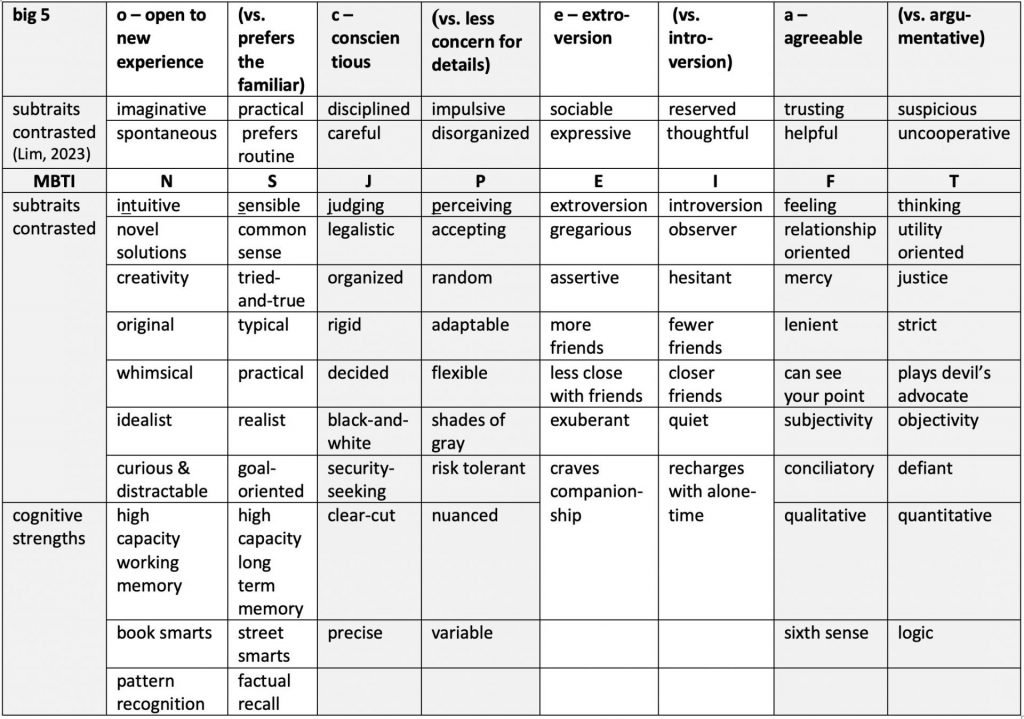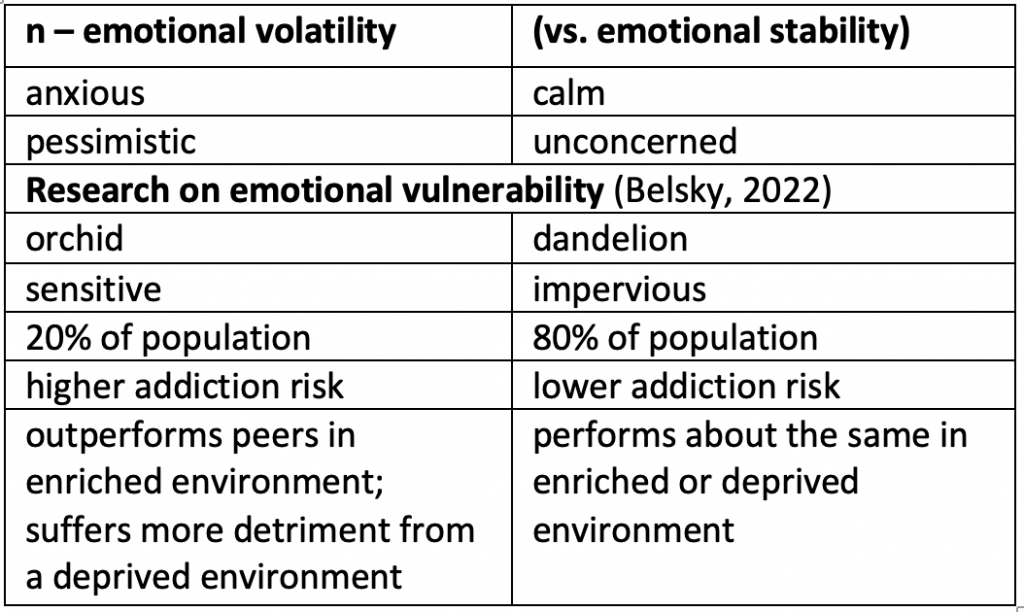Temperament types are generalizations that often won’t hold true, because most people have a balance rather than tending to the extreme of a trait. Yet see what fits for you. The following descriptions are based on the Big 5 personality traits, as well as the MBTI. They’re presented in the order of the Big 5 OCEAN acronym: openness, conscientiousness, extroversion, agreeableness, and neuroticism. Before reading the following paragraphs, you will get more out of it if you take the tests for the Big 5 and MBTI to see what applies to you. Scores from both measures can be recorded in your ICmatch profile in the personality section. There’s a $10 more complete version of a big 5 assessment, which can include group purchase and assessment about how your traits complement or clash with others’ traits. The following paragraphs discuss the personality types and IC team member roles within an intentional community.

Openness
High openness (high in MBTI intuitive [N])
You are the backbone of the intentional communities movement. You’re excited to explore the possibilities of new social structures and reject the idea that established norms and procedures are too fixed to change. It’s your thinking outside the box that generates so many breakthroughs. Hopefully you have enough similar others in your group to support your openness adventures, even when their novel ideas don’t fit seamlessly with yours. It will require some give and take to make sure everyone’s creativity can be nurtured. It’s when your group can unite various elements of your creative visions in collaboration that your whole community could explode into the type of artistic and innovative expression that can draw outsiders to a state of awe, such as with the majestic architecture of Arcosanti or the glass kaleidoscopes of the Taos earthships.
Where your community members can help you is to convince you to spend more time in the physical world. They can help you come down to earth when you have for a bit too long had your head in the clouds. When you lose track of where the box even is, they can point it out.
Low openness (high in MBTI sensing[S])
I think it’s easiest to keep track of this trait as represented by a concrete thinking style, where you are good at keeping track of facts and are less interested in theories or possibilities. You’re practical, interested in the way things are. You’re more interested in history than fantasy. This is a good balance to the idealists who tend to be interested in intentional community as a novel and experimental social project. You may find yourself siding more with the broader culture sometimes in advocating for some kind of virtue or necessity in the way things are “typically” done, rather than reinventing the wheel constantly, as other community members may prefer. To put it bluntly, their enthusiasm for variety and novelty may not translate often enough to following through with difficulties of figuring out how to do a task or project effectively in a non-standard manner. You and other S-types may be the ones who have to at times voice a paramount objection. It may be helpful to at times have parallel projects, one operating in the standard manner and the other in a new creative manner. Or you might advocate to give a time limit to the trial of a proposed innovation. While the creatives might be kept busy for a while reinventing the rules, they may eventually run out of steam and admit the tried-and-true way worked well enough.
Where your high-openness community members might delight you most is in their culinary creations. They also are gifted in arts and other new enjoyments when you feel stuck in a rut.
Conscientiousness
High conscientiousness (high in MBTI judging[J])
You’ll have a big advantage in some ways because this trait is associated with high achievement. You’ll be a big asset to your group. There aren’t as many people high in this trait who are interested to live in intentional community, yet your particular skills and tendencies are necessary to hold down the fort. The early communes of the ‘60s, at least as they are portrayed in stories from that time, seemed to largely fail because of a lack of this trait. People thought it wasn’t necessary to have schedules and someone detail oriented making sure bills got paid on time. No surprise that the majority of the communes eventually closed down. You may have to keep reminding your people that good intentions aren’t enough to keep the IRS from closing you down. You actually have to take care of bookkeeping. Fortunately, all you need is an excel spreadsheet. You don’t have to be a math wiz to take care of business. Just keep the records and hire a good tax accountant once a year.
Where your group can help you is to insist that you take a break more often than you might feel like it, to participate in fun activities. They might be what keeps you balanced.
Low conscientiousness (high in MBTI perception[P])
You have a big advantage in that you will be very accepting of a wide variety of temperaments. Rather than evaluating their merits, you tend to simply accept people for who they are. This is an incredibly valuable trait to have as a mediator and as someone who people trust as a confidant, because your likely to not judge them. You may find yourself being asked to support others as they try to mediate a conflict or need a friend to come with them to discuss a challenge with another group member. In Aesop’s ant and the grasshopper fable, you’re definitely the grasshopper. You appreciate having food for the winter, but you can keep things lively and fun in a way that the ants might need, especially when they see how valuable that is for keeping kids entertained away from their screens.
Left to your own motivations you might tend to do a whole lot less to prepare for the next season, and miss out on opportunities. Where your group can help you is to create structure, because that’s probably not your strong point. However, structure and routine can help life go more smoothly.
Extraversion
High extraversion
This is a trait that tends to be valued in general society, and especially in intentional community where it doesn’t work to hide away from others. You’re going to be valued as a greeter and to coordinate with the larger community external to your group. You might find yourself being the one planning outings when others are content to stay in their boring contemplative solitude. You can help your group by coaxing the introverts out of their comfort zone.
Low extraversion (high introversion)
You might value intentional community as it can allow you to interact most often with known personalities, rather than being constantly faced with strangers that cause you mild anxiety. You will have an advantage in tolerating the solitary tasks that high extraverts find tedious when unaccompanied. One can chat while gardening, but not very effectively while responding to emails. While introversion was once stigmatized, Susan Cain’s bestselling research-packed book Quiet has brought new understanding and respect to the discussion of this trait.
Agreeableness
High agreeableness (high in MBTI feeling [F])
You’re part of the reason that intentional community has any chance whatsoever of working out. You are among those who have an intrinsic motivation for everyone to get along and cooperate. This makes the group stronger and prevents you from wasting time in fruitless contentions, because sometimes differences are so minor they simply don’t warrant mention or attention. You tend to go along to get along, and usually this is a good way to keep community humming along.
While you might find it alarming to have less agreeable comrades among you, they are valuable to make sure your friendliness has a limit. They will be the ones who help individuals like yourselves to remember to set some necessary boundaries and to identify problematic personalities. You can’t get far in saving the world if you’re giving away the farm or not noticing who might be keen to take it over. Better to maintain your intentional community with less generosity if that’s what it takes to remain an example of how to maintain self-sufficiency and harmony.
Low in agreeableness (high in MBTI thinking [T])
You’ll be valued for encouraging accountability, for not letting too much compassion and mercy degrade the standards of the group. This can be a challenge, because you are likely to be surrounded by the typical community seekers who are there precisely because they value compassion and tend toward conflict aversion. When others are too nice to put a stop to dysfunctional behaviors, you tend to have the fortitude to speak up and to act, to make that unpopular paramount objection. You are not as afraid of conflict as your many agreeable friends.
Fortunately, you will have many highly agreeable folks around to keep communication flowing and to motivate everyone to do the challenging work of dissecting interpersonal challenges. Left to your own tendencies, you might tend to simply avoid or fight with those you don’t agree with.
Neuroticism
High in neuroticism
Typically this isn’t seen as a desirable trait. High neuroticism is seen in one out of five, 20% of the population. Those high in neuroticism tend more easily toward anxiety, depression, and reactivity in challenging circumstances. They’re less hardy, more orchids than dandelions (Belsky, 2022). They’re special snowflakes whether they want to be unique or not. This can be a challenge for others to deal with. If you’ve experienced trauma or are experiencing current overwhelming challenges, you could be seen as extra delicate, someone that others have to walk on eggshells around. This tendency may even lead to health challenges if consistent stress works its destruction on your physical constitution.
Fortunately, there are ways to counteract this tendency. Spiritual development typically helps increase emotional maturity, temper emotional reactivity, and in general helps you to have a larger perspective that can counter your potential to spiral into negative thinking such as catastrophizing. Used well, spiritual development can turn this weakness into a strength. One often unconsidered aspect of this trait is that it includes sensitivity to the external environment. You are the least likely to tolerate well a damaging environment; you simply need to get out of a bad situation, rather than try to manage it. On the other hand, you are the most likely to flourish in a very enriched environment. Under the most favorable circumstances, you should benefit more than your peers do from the advantages that come your way.
As with every trait that has survived in the population in higher numbers, there is something adaptive to be found in this trait. One advantage you have is that you tend to notice more than the majority of your peers do. While others can focus in to follow a certain ambition, you remain more cautious and curious, picking up on both opportunities and dangers that others miss in their dogged pursuit of whatever obvious goals are worth pursuing. It may be true that your attention can be scattered and unfocused, and this is precisely the trait that is needed when unexpected threats or opportunities arise.
At the same time, you sometimes overdo it. Your friends who have your best interest at heart can help calm you down when they’ve been able to assess that the danger has passed or was a false alarm. With their help, you can live in more equanimity than you would otherwise.
Low in neuroticism
At the extreme of this trait, you are sturdy, even keel, unflappable. This can make you seem good leadership material, because you seem confident in your decisions. This can help others rally to support a plan for moving forward. Sometimes it isn’t so important whether you have the best idea; it’s simply your capacity to convince everyone to move in the same direction that gets the job done. Even if you don’t have extroversion or feel a capacity to coordinate others, you’ll be valued as someone who can be counted on for consistency. You don’t need coddling or special treatment, and this can be a relief and a help, especially during times of crisis when others’ emotions are “out of control.”
While it may sometimes drive you crazy, those high in neuroticism offer a necessary balance. Even if you are annoyed that they sometimes sound a false alarm, your friends high in neuroticism also are likely to notice more quickly than you would, and sound the alarm, when there actually is a danger. They balance your overconfidence and feeling of invulnerability.
Big 5 Traits
The Big 5 is the most research-validated of personality schemas. See Wikipedia for a well-cited summary of its development and uses. The five factors (traits) are openness to new experience, conscientiousness, extraversion, agreeableness, and neuroticism (Lim, 2023). Neuroticism is defined as emotional volatility, more tendency toward mood fluctuation, or in psych-speak referred to as mood lability.
MBTI Temperament Types
Based on Jungian archetypes, the Myers-Briggs Temperament Type Indicator (MBTI) sorts people into four main types, each with four subtypes, for a total of 16 subtypes (Faust, 2019). The MBTI traits overlap strongly with the Big 5, as detailed in the chart that follows. The MBTI goes further than the Big 5 in that it looks at combinations of the traits. It is interested in what particular temperaments come out of the combinations of traits: SP, SJ, NF, NT. For example, high intuition (N) expresses differently combined with a high feeling (F) temperament as opposed to a high thinking (T) type. Both are creative, but one shows the creativity of a musician while the other is more likely to channel their creativity into innovative engineering or technology. Unlike the Big 5, the MBTI leaves out neuroticism, but some MBTI theorists are starting to incorporate this dimension into their descriptions. Much has been written about the job fit and interpersonal characteristics of these types, which may be helpful to review when considering roles within an intentional community.
Overlap of Traits in the Big 5 and MBTI
The MBTI has a popularity and face validity that has made it a favorite of the business world’s human resources consultants and organizational change courses. There appears to be overlap between the Big 5 and the MBTI. In this chart, each Big 5 trait is placed above its MBTI counterpart. Each of the Big 5 traits has its opposite next to it, for example extroversion versus introversion.

Trait-neuroticism Chart

References
Belsky, J. (2022). Your kid is probably not an ‘orchid’ or a ‘dandelion’—but could be both. https://www.scientificamerican.com/article/your-kid-is-probably-not-an-orchid-or-a-dandelion-but-could-be-both/
Faust, K. (2019, April 11). Myers-Briggs Type Indicator (MBTI) overview. https://leadx.org/articles/mbti-myers-briggs-type-indicator-overview/
Lim, A. G. Y. (2023). Big five personality traits: The 5-factor model of personality. https://www.simplypsychology.org/big-five-personality.html#neuroticism